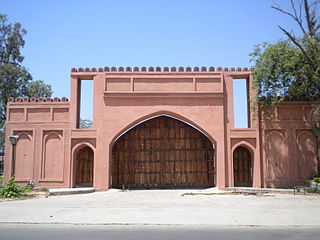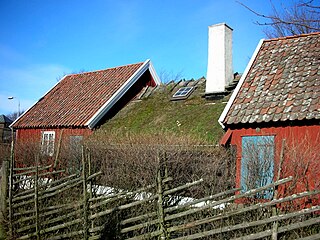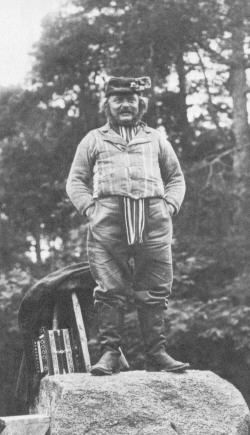
Skansen is the oldest open-air museum and zoo in Sweden located on the island Djurgården in Stockholm, Sweden. It was opened on 11 October 1891 by Artur Hazelius (1833–1901) to show the way of life in the different parts of Sweden before the industrial era.

Folk art covers all forms of visual art made in the context of folk culture. Definitions vary, but generally the objects have practical utility of some kind, rather than being exclusively decorative. The makers of folk art are typically trained within a popular tradition, rather than in the fine art tradition of the culture. There is often overlap, or contested ground with 'naive art'. "Folk art" is not used in regard to traditional societies where ethnographic art continue to be made.

Artur Immanuel Hazelius was a Swedish teacher, scholar, folklorist and museum director. He was the founder of both the Nordic Museum and the Skansen open-air museum in Stockholm.

An open-air museum is a museum that exhibits collections of buildings and artifacts outdoors. It is also frequently known as a museum of buildings or a folk museum.

The Nordic Museum is a museum located on Djurgården, an island in central Stockholm, Sweden, dedicated to the cultural history and ethnography of Sweden from the early modern period to the contemporary period. The museum was founded in the late 19th century by Artur Hazelius, who also founded the open-air museum Skansen. It was, for a long time, part of the museum, until the institutions were made independent of each other in 1963.

"ASTRA" National Museum Complex is a museum complex in Sibiu, Romania, which gathers under the same authority four ethnology and civilisation museums in the city, a series of laboratories for conservation and research, and a documentation centre. It is the successor of the ASTRA Museum that has existed in the city since 1905. Its modern life started with the opening of The Museum of Folk Technology in 1964, now The "ASTRA" Museum of the Traditional Folk Civilization.
DakshinaChitra is a living-history museum in the Indian state of Tamil Nadu, dedicated to South Indian heritage and culture. It is located 25 kilometres (16 mi) to the south of Chennai. Opened to the public on 14 December 1996, the museum was founded and is being managed by the Madras Craft Foundation (MCF). The MCF was established in 1984. Deborah Thiagarajan, an Indian art historian of American origin, governs the museum. The museum is built on 10 acres (4.0 ha) of land taken on a 33-year lease from the Government of Tamil Nadu. Located at Muttukadu, on the East Coast Road connecting Chennai and Pondicherry, the site overlooks Bay of Bengal.

Pyrohiv, originally a village south of Kyiv, now the National Museum of Folk Architecture and Folkways of Ukraine, is a 133.5 hectare open-air museum located at 1 Laureatska Street, Kyiv, Ukraine. An architectural and landscape complex representing the major historical and ethnographic regions of Ukraine, it is dedicated to the preservation and study of regional Ukrainian folkways.

Kulturen is an open air museum in Lund in Lund, Sweden. Occupying two blocks in central Lund, Kulturen is Sweden's and the world's second oldest open-air museum after Skansen in Stockholm. It contains historic buildings, dating from the Middle Ages to the 1930s, set in gardens or cobblestone streets. The complete name of the museum is Kulturhistoriska föreningen för södra Sverige.

Heritage Museum, also known as Lok Virsa Museum, is a museum administered and managed by Lok Virsa - National Institute of Folk & Traditional Heritage.

The Giorgi Chitaia Open Air Museum of Ethnography is an open-air museum in Tbilisi, Georgia, displaying the examples of folk architecture and craftwork from various regions of the country. The museum is named after Giorgi Chitaia, a Georgian ethnographer, who founded the museum on April 27, 1966. Since December 30, 2004, it has been administered as part of the Georgian National Museum.

The Ethnographic Open-Air Museum of Latvia is an open-air museum located just outside Riga, the capital of Latvia, on the lightly wooded shores of Jugla Lake.

The Bexell Cottage is a small cottage in Varberg, Sweden. It has been turned into a historical heritage mini-museum. In Bexell Cottage there are furnitures and painted wall tapestry from the 19th century. The tapestry cover the walls and ceiling of the cottage. Originally, they were only used for Christmas, but today they are posted all the year around. Bexell Cottage can be visited by the public at the shows of the cottage that are arranged by Halland Museum of Cultural History.

Known as the father of bondkomik, Jödde i Göljaryd (1855–1900) was a beloved storyteller, whose folk humor and songs dominated popular culture in Sweden during the 1890s.

The Abbey Museum of Art and Archaeology, is an Australian public museum dedicated to the preservation and display of antiquities, fine art, archaeology and cultural heritage. Situated in Caboolture, Queensland, it opened in 1986. Displaying a unique collection of tools, weapons, pottery, ornaments, furniture and other artefacts, the Abbey collection spans through prehistoric hunters; the age of bronze and gold; great civilisations of Egypt, Mesopotamia and Greece; the Roman Empire; medieval knights, plagues and illuminated manuscripts; Renaissance Europe; and art from India and the Far East. The museum is the heir to the collections of the Abbey Folk Park (1934–1945) at Park Road, New Barnet; Great Britain's first open-air Folk Museum, and has been recognised as a nationally significant heritage collection.

Shilpgram is a rural arts and crafts complex, situated 3 km (1.9 mi) west of the city of Udaipur, Rajasthan state, India. The center is spread over an undulating terrain of about 70 acres of land, surrounded by the Aravali mountains. Shilpgram is an ethnographic museum that depicts the lifestyles of the folk and tribal people of the region. With an objective of increasing awareness and knowledge about the rural arts and crafts, the Shilpgram provides opportunity for rural and urban artists to come together and interact through the process of camps and workshops.

Gunnel Gunnarsdotter Hazelius-Berg née Hazelius (1905–1997) was a Swedish museum curator, textile researcher and writer. She spent her entire professional career at Stockholm's Nordic Museum. As the director responsible for textiles, over the years she arranged several highly acclaimed exhibitions. Hazelius-Berg took a special interest in traditional Swedish costumes. Together with her daughter-in-law Inga Arnö-Berg, in 1975 she published Folkdräkter och bygdedräkter från hela Sverige which was translated into English as Folk Costumes of Sweden: A Living Tradition.

Västernorrland County Museum is the regional museum of Västernorrland County, Sweden. One of Sweden's 24 county museums, Västernorrland County Museum has the aim to preserve and transmit the cultural history of Västernorrland. The collections are based on history, archaeology, ethnology, culture and art. The museum's head office is currently located at Härnösand in Härnösand Municipality. Among the museum's many activities, the extensive exhibition activities are one of the most important. Other very important activities concern the preservation of old buildings and the care of the county's cultural heritage environments and archaeological sites, a work that is carried out in collaboration with the County Administrative Board of Västernorrland. The museum serves all inhabitants in the county. It documents both prehistorical and historical structures in the county and promotes the visiting of them. The current museum director is Jenny Samuelsson and the current chairman is Carl L. Thunberg. Among the areas covered by the museum is the UNESCO World Heritage Site of the High Coast area.


















